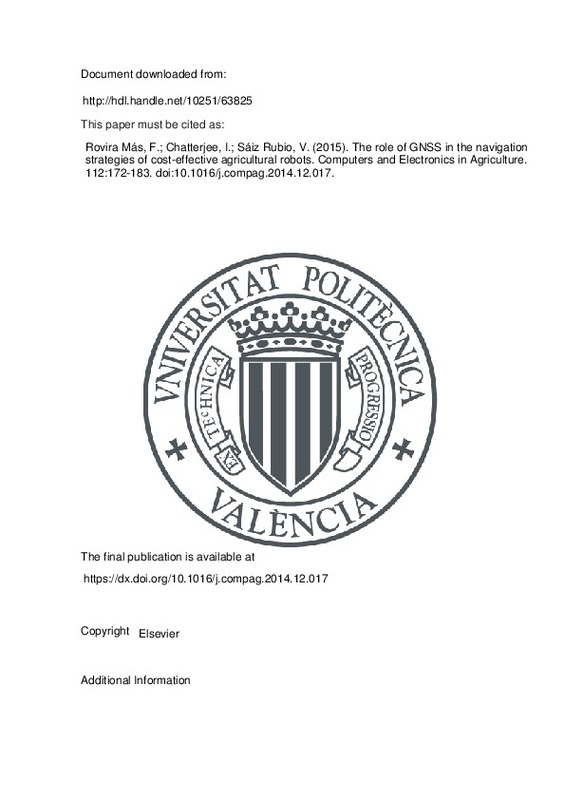JavaScript is disabled for your browser. Some features of this site may not work without it.
Buscar en RiuNet
Listar
Mi cuenta
Estadísticas
Ayuda RiuNet
Admin. UPV
The role of GNSS in the navigation strategies of cost-effective agricultural robots
Mostrar el registro sencillo del ítem
Ficheros en el ítem
| dc.contributor.author | Rovira Más, Francisco
|
es_ES |
| dc.contributor.author | CHATTERJEE, ISHANI
|
es_ES |
| dc.contributor.author | Sáiz Rubio, Verónica
|
es_ES |
| dc.date.accessioned | 2016-05-10T07:31:07Z | |
| dc.date.available | 2016-05-10T07:31:07Z | |
| dc.date.issued | 2015-03 | |
| dc.identifier.issn | 0168-1699 | |
| dc.identifier.uri | http://hdl.handle.net/10251/63825 | |
| dc.description.abstract | [EN] The current state of automation technology has led to a growing interest in the design and development of new use-case agricultural robots that can provide effective solutions to the challenges that agriculture is facing in industrialized countries, especially those derived from labor shortage and ever-increasing production costs. The advent of autonomous moderate-size machines in the field appears as a prospective way of promoting the sustainable production of food in Europe, Japan, and North America. However, there exist important obstacles to the broad expansion of autonomous robots in the field; reliability, safeguarding, system complexity, and cost-efficiency in particular rank high among the impediments to overcome before prototypes move into the production stage. Robot navigation is essential for the successful deployment of autonomous machines in conventional farms, as a minimum level of safety has to be granted at the same time that navigation engines cannot be too sophisticated for solutions to compete with current equipment. In such compromise, global navigation satellite systems play a key role due to its wide range of solutions, and an important number of limitations. In this research, a variety of experiments were conducted to determine the scope of GNSS solutions as a principal component of the navigation system of novel farm robots. Results showed that regardless of the quality of the receiver used, multipath and other uncontrollable errors eventually occur in the field, and therefore signal consistency must be continuously checked by the robot’s navigation engine. Different strategies based on the meticulous analysis of NMEA strings, the optimal combination of GGA and VTG messages, and the trajectory-based redundant estimation of robot planar states are proposed to enhance the integration of GNSS measurements in the navigation engine of agricultural robots. 2014 Elsevier B.V. All rights reserved. | es_ES |
| dc.language | Inglés | es_ES |
| dc.publisher | Elsevier | es_ES |
| dc.relation.ispartof | Computers and Electronics in Agriculture | es_ES |
| dc.rights | Reserva de todos los derechos | es_ES |
| dc.subject | GNSS | es_ES |
| dc.subject | Farm robots | es_ES |
| dc.subject | Agricultural robotics | es_ES |
| dc.subject | Navigation strategies | es_ES |
| dc.subject | Autonomous navigation | es_ES |
| dc.subject.classification | INGENIERIA AGROFORESTAL | es_ES |
| dc.title | The role of GNSS in the navigation strategies of cost-effective agricultural robots | es_ES |
| dc.type | Artículo | es_ES |
| dc.identifier.doi | 10.1016/j.compag.2014.12.017 | |
| dc.rights.accessRights | Abierto | es_ES |
| dc.contributor.affiliation | Universitat Politècnica de València. Departamento de Ingeniería Rural y Agroalimentaria - Departament d'Enginyeria Rural i Agroalimentària | es_ES |
| dc.description.bibliographicCitation | Rovira Más, F.; Chatterjee, I.; Sáiz Rubio, V. (2015). The role of GNSS in the navigation strategies of cost-effective agricultural robots. Computers and Electronics in Agriculture. 112:172-183. doi:10.1016/j.compag.2014.12.017 | es_ES |
| dc.description.accrualMethod | S | es_ES |
| dc.relation.publisherversion | https://dx.doi.org/10.1016/j.compag.2014.12.017 | es_ES |
| dc.description.upvformatpinicio | 172 | es_ES |
| dc.description.upvformatpfin | 183 | es_ES |
| dc.type.version | info:eu-repo/semantics/publishedVersion | es_ES |
| dc.description.volume | 112 | es_ES |
| dc.relation.senia | 285095 | es_ES |
| dc.identifier.eissn | 1872-7107 |







![[Cerrado]](/themes/UPV/images/candado.png)

